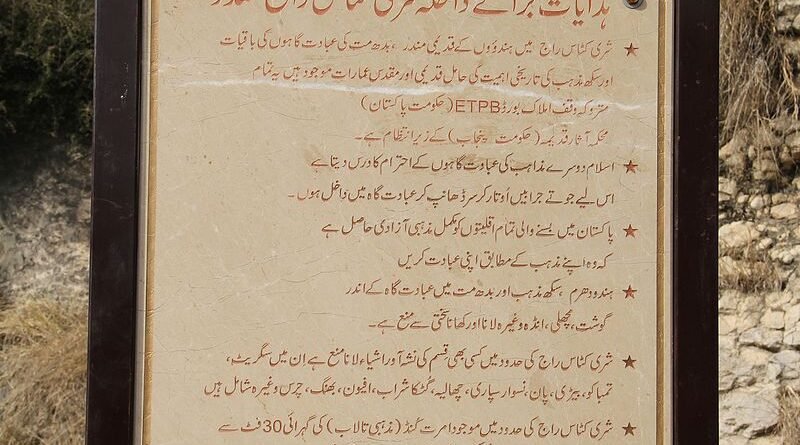Katas Raj Temple Complex Pakistan
The Shri Katas Raj Temples also known as Qila Katas is a complex of several Hindu temples connected to one another by walkways. The temple complex surrounds a pond named Katas which is regarded as sacred by Hindus.
The complex is located in the Potohar Plateau region of Pakistan’s Punjab province. The temples are located in municipal committee Choa Saidanshah, and are near the M2 Motorway.
The temples’ pond is said in the Puranas to have been created from the teardrops of Shiva, after he wandered the Earth inconsolable after the death of his wife Sati.
The pond occupies an area of two kanals and 15 marlas, with a maximum depth of 20 feet.
Serial Kanpur Se Katas Tak was also shot here starring Saba Qamar in 2010 aired on Indus Vision. The temples play a role in the Hindu epic poem, the Mahābhārata,where the temples are traditionally believed to have been the site where the Pandava brothers spent a significant portion of their exile.It is also traditionally believed by Hindus to be the site where the brothers engaged in a riddle contest with the Yakshas, as described in the Yaksha Prashna.
Another tradition states that the Hindu deity Krishna laid the foundation of the temple, and established a hand-made shivling in it.
The temples were visited by India’s former deputy prime minister Lal Krishna Advani in 2005. In 2006, the Pakistani government began restoration works at the temples, with further improvements announced in 2017.
History
Prehistoric
The Salt Ranges have archaeological remains still hidden underground. A number of bones of the limbs and vertebrae of animals have been found at some nearby sites. Prehistoric axes and knives made of granite, and artifacts like terracotta bangles and pottery have also been unearthed at the Katasraj site. The latter have been found to be similar to those excavated in Harappa, but have not been dated.
Hindu tradition holds that the temples date from the era of the Mahabharata, and is believed to be where the Pandava brothers spent a large portion of their exile.It is also believed by Hindus to be the site where the Pandavas engaged in a riddle contest with the Yakshas, as described in the Yaksha Prashna.
Founding
The founder of the Sikh faith, Guru Nanak, is believed to have visited the Katas Raj Temples, as the site became a popular destination for ascetics.The Sikh emperor Ranjit Singh also regularly performed pilgrimage to the site.He visited the site for the Vaisakhi festival in 1806, in December 1818,and again in 1824.
The complex was a popular pilgrimage site for Hindus prior to the 1947 Partition of British India, with large numbers visiting for Shivratri. Following Partition, the local Hindu community left the region for India. The relationship of Hindus with local Muslim population was good, and local Muslims accompanied Hindus to the nearby town of Choa Saiden Shah, from where the local Hindu population departed for India. Indian pilgrims continued to visit the temple for the Shivratri festival until the Indo-Pakistani War of 1965, after which Indian pilgrims were barred from visiting again until 1984.
Modern
The temples fell into disrepair over the decades following Partition, and suffered neglect. Pakistani Hindus would continue to occasionally visit the site, but were unable to maintain the expansive complex. The pond was polluted with litter, while local villagers would also use the pool for recreation.Indian Hindu pilgrims were forbidden to visit the site in 1956, 1960,and after the Indo-Pakistan war in 1965.India pilgrims were not permitted to visit the site again until 1984.
India’s former Deputy Prime Minister Lal Krishna Advani visited the temples in 2005,and expressed displeasure at the site’s dilapidated state.In 2005 Pakistan proposed to restore the temple complex, while in 2006 the restoration project began in order to clean the sacred pond, paint and restore some temples, and installation of informational blue boards around the temple complex.300 Indian Hindus visited the site for the Shivratri festival in 2006,which for a short time became an annual tradition for some Indian pilgrims, though Indians stopped coming after the 2008 Mumbai attacks.2,000 Pakistani Hindus resumed the tradition of celebrating Shivratri at the temple in 2010,[10] and another 2,000 in 2011 with visitors coming from as far as Karachi.A wedding for Hindu couples was arranged during that year’s Shivratri festival for couples from Khyber Pakhtunkhwa province whose families had lost much of their property in the 2010 Pakistan floods.
In January 2017, Pakistan’s government began installation of shikharas on the temples.In February 2017, 200 pilgrims from India traveled to the temple to participate in the Katas Raj Dham festival.[18] In 2018, Pakistan issued visas to 139 Indian Hindu pilgrims to visit Katas Raj dham.






















